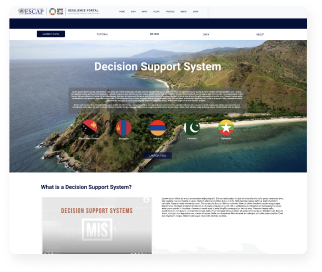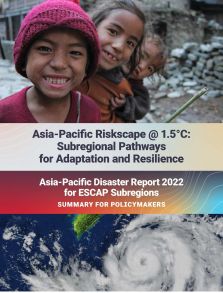Paragraphs
Body
Overview of Risk and Resilience in Asia-Pacific
Hazard Hotspots
Examine the data on hazard exposure and assess the impacts and vulnerabilities
for these hazards to develop crisis management and risk mitigation plans helping in hazard preparedness.
Know more
Economic Impact
A tool providing an overview of direct economic losses relative to global and
gross domestic product as a result of hazards and natural disasters over the years across various regions in
Asia-Pacific.
Know more
Adaptation Cost and Priorities
Access the graphs and information on cost and priorities of climate adaptation in
different Asia-Pacific subregions in order to strengthen resilience, warning systems and preparedness
mechanisms.
Know more
Body
Resilience SDG Action Tracker
The Resilience SDG Action Tracker (RSAT) of the ESCAP Asia-Pacific Risk and Resilience Portal monitors and tracks the disaster and climate related SDG targets and indicators available in the ESCAP SDG Gateway. It provides users with comprehensive, easy to use data analytics (using machine learning and automation) on the disaster and climate related SDG trends for countries and subregions of the Asia-Pacific noting the impacts on social, economic and environment sectors, and demonstrates the key pathways of adaptation that can either reverse the regressing trends or support the positive trends in SDG implementation for resilience.
Body
Decision Support System
Explore sub-national data in some target countries for evidence-based policy making.
To the System

Body
Country Analysis
Data Explorer
Access the data exploration tools and information to stay updated on the hazards and its impacts across various
regions in Asia-Pacific.
Know more
Policy Search and Policy Matrix
Use smart search function to quickly locate policy information on disaster risk reduction and climate action priorities and targets.
Know more
Country Profile
Find key data and information on the disaster-climate-health nexus and sustainable development for different Asia-Pacific countries.
Know more
Body
About the Risk and Resilience Portal
Why create the Risk and Resilience Portal?
The Risk and Resilience Portal, under the Asia-Pacific Disaster Resilience Network, has been established to deepen policymakers' understanding of cascading risks from the disaster-climate-health nexus, provide evidence
based analytics to strengthen regional cooperation frameworks to conduct and produce actionable risk assessments,
and strengthen capacity of multiple sectoral ministries to develop risk informed planning and budgeting.
What can you find in the Risk and Resilience portal?
The portal will answer four key questions on the emerging disaster-climate-health riskscape. Where are the
risk hotspots of cascading hazards. What are the current and future economic losses from cascading hazards.
How much will it cost countries, the subregions, and the region to adapt to the new riskscape. What
are the adaptation priorities for countries, sub-regions and the region.
What is the Asia-Pacific Disaster Resilience Network?
Disasters disproportionately impact poor and marginalized groups and limit the ability of economic growth to
eradicate poverty and reduce inequality. ESCAP’s flagship report on disaster risk reduction, the Asia-Pacific
Disaster Report continues to present empirical evidence that many high-risk countries may not be able achieve
multiple sustainable development goals by 2030 if disaster risks are not mitigated. The convergence of natural and
biological hazards (as demonstrated by the impacts of COVID-19) have expanded the disaster riskscape of the Asia
Pacific region. This riskscape is further intensified by the impacts of climate change. To address the
disaster-climate-health riskscape and the ensuing cascading risks on SDG progress, Governments need to adopt
strategies that move beyond the traditional focus on a hazard-by-hazard approach to a multi-hazard approach. Led
by ESCAP and implemented in collaboration with various partners, the Asia-Pacific Disaster Resilience Portal aims
to strengthen the capacity of countries in Asia and the Pacific to mitigate the impacts of cascading risks on the
achievement of the Sustainable Development Goals (SDGs).
Body
Body
Methodology
The methodology consists of 3 parts:
1) Exposure in hazard hotspots
Calculations and mapping based on global spatial datasets on natural and biological hazards, health-related indicator, and socio-economic vulnerability, and critical infrastructure such as health facilities, energy and transport infrastructure.
Calculations and mapping based on global spatial datasets on natural and biological hazards, health-related indicator, and socio-economic vulnerability, and critical infrastructure such as health facilities, energy and transport infrastructure.
2) Economic impact
Calculations based on probabilistic impact of population exposure to natural and biological hazards under current scenarios, future climate change scenarios; combined with health care spending data.
Calculations based on probabilistic impact of population exposure to natural and biological hazards under current scenarios, future climate change scenarios; combined with health care spending data.
3) Adaptation cost and priorities
Calculations based on proxy to 5 adaptation measures, and the above-mentioned calculations.
Calculations based on proxy to 5 adaptation measures, and the above-mentioned calculations.
Body



